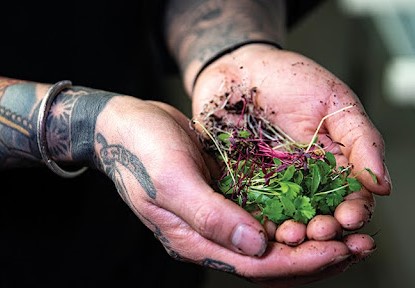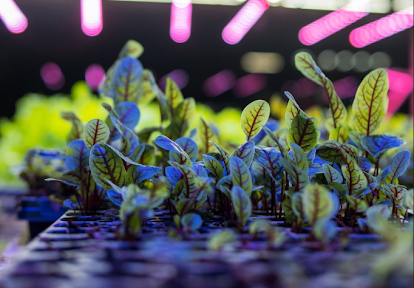Vertical Farming 101: How Growing Up is Feeding the Future
With the world’s population growing and agricultural land shrinking, how can we ensure a sustainable food future? Vertical farming is a paradigm-shifting new agriculture method that triples yields, uses less water, and increases food security.
In this blog, we will discuss how emerging agricultural practices, such as vertical farming, are changing the face of food production.
What is Vertical Farming?
Vertical farming is an indoor farming technique that involves growing crops within vertically stacked tiers rather than using horizontal rows of soil. Indoor farms employ climate control, hydroponic facilities, and light-emitting diodes to give the best output for plant production.
Vertical farming does not involve the use of soil, natural weather patterns from seasons, or excess water when compared to common farming practices, making it even more efficient and sustainable. By utilizing automated systems, vertical farms can grow crops all year round with minimal human intervention.
This provides a steady supply of food, even in urban areas where traditional farming is not possible. Vertical farming also reduces long-distance transportation of food, lowering carbon emissions and improving the freshness of food. Isn’t that interesting?
The Evolution of Modern Farming Techniques
Indoor agriculture started many centuries ago with Babylonian hanging gardens, but with the development of technology, it scaled up. The phenomenon gained momentum in the 20th century when hydroponic systems were invented to cultivate crops in the absence of soil. Urban agriculture emerged as an initiative to alleviate food shortages and the difficulties of delivering fresh food to cities.
Modern technology, such as hydroponics, aeroponics, and aquaponics, enables farmers to produce food under climate-controlled conditions, transforming the way food is produced. With the latest technology, vertical farming is an achievable option for sustainable food production in highly populated urban cities, providing fresh and healthy food for increasing populations.
Why Vertical Farming is the Future of Food Production

Vertical farms consume 95% less water than conventional farms by recirculating nutrients in a closed-loop system. Because crops are planted in vertical layers, vertical farming takes up to 99% less space than conventional farming. No herbicides or pesticides are required, eliminating toxic chemical runoff into the environment.
Vertical farms also employ energy-efficient LED lighting and computerized climate control to eliminate waste and maximize plant growth. The capacity for recycling water and nutrients makes this technique one of the most eco-friendly farming practices in existence. With the globe increasingly threatened by environmental issues, vertical farming is an option that can help mitigate the environmental impact of food cultivation.
Bringing Agriculture to Urban Areas
Through urban agriculture, produce can be cultivated near consumers, minimizing the necessity for long-distance transportation. The result is fresher produce with a longer lifespan and less carbon footprint from food distribution. New York, Tokyo, and Singapore are among the cities that have adopted vertical farming to fight food deserts and enhance food security.
By reusing existing infrastructure like warehouses and parking garages, vertical farms optimize underutilized urban spaces. Furthermore, these farms lower the reliance on imports and provide a stable, year-round source of high-quality produce, hence a critical solution to food shortages in highly populated regions.
Year-Round Crop Production
In contrast to seasonal farming, which is constrained by the seasons, controlled environment agriculture can have crops grown year-round, 365 days of the year. Farmers can set temperature, humidity, and CO₂ levels to optimize plant development. This allows for consistent food production regardless of outside weather patterns.
Eliminating dependence on climate conditions reduces the risk of damage from extreme weather patterns and seasonal crop loss for vertical farms. Sophisticated lighting systems simulate natural sunlight to offer the best photosynthesis conditions for crops to grow efficiently. Farmers have more control over environmental factors, and therefore, they can produce more and have a steady food supply year-round.
Space Optimization in Cities
Conventional farms take big, open areas, which are limited in cities. Vertical farms use warehouses, rooftops, and shipping containers to grow high-yielding crops in compact spaces. Balance Farms, for instance, has converted urban spaces into highly successful indoor farms. By growing crops vertically, these farms can make efficient use of limited square meters, delivering much more food per square meter compared to conventional agriculture.
Moreover, vertical farming systems with modularity ensure scalability, that is, farms can be sized to suit spaces. This scalability ensures that vertical farming is an economical means of producing food where farmland cannot be accessed.
Climate Resilience & Food Security
Severe weather, floods, and soil erosion make conventional farming more challenging. Vertical farming is climate change-resistant because it is conducted indoors in controlled environments. This provides a consistent food supply, even in regions where conventional farming is not feasible. Because crops are shielded from volatile weather conditions like floods, storms, and wildfires, food supply chains are not disrupted.
Vertical farming diminishes dependence on land that is arable, conserving natural ecosystems. With climate change posing a persistent danger to global food production, investment in vertical farming can improve food security and lower the risks of agricultural instability.
Economic & Job Growth in Agriculture
Vertical farms establish new employment opportunities in city centers, ranging from agricultural technicians to data analysts. The sector is expected to expand considerably, providing avenues for individuals in STEM careers, engineers, and sustainability experts.
Balance Farms is the new evolving pioneer in vertical farming, which is investing in local economies while changing the face of sustainable farming.
As automated and AI-based farming systems grow, there is an increasing need for trained professionals in areas like robotics, plant biology, and environmental engineering. Moreover, urban agriculture promotes local food markets, giving communities access to fresh produce while promoting economic growth in cities.
The Technology Behind Vertical Farming

Hydroponics, Aeroponics, and Aquaponics
- Hydroponics is a soilless cultivation technique where plants are nourished with a water-soluble solution, enabling exact control of growing conditions.
- Aeroponics goes one step further by misting the plant roots with nutrient-laden water, with up to 95% less water than conventional agriculture.
- Aquaponics combines hydroponics with aquaculture, where fish waste is used as fertilizer for plants, forming a closed ecosystem.
These technologies cut down greatly on water usage, do away with chemical fertilizers, and yield more. Through the utilization of these high-tech growing methods, vertical farms can grow food sustainably with minimal usage of resources.
The Role of AI and Automation
Artificial intelligence-powered sensors track plant development, dynamically adjusting light, temperature, and water levels to maximize yields. Machine learning-based algorithms review data to forecast crop performance and flag potential problems before they impact production.
Automation within vertical farms lowers labor expenses but boosts accuracy, guaranteeing every plant the optimal conditions for growth. Future robotics development might further optimize the harvesting process, leading to more efficient large-scale vertical farming. Blockchain technology might also increase food production transparency, enabling customers to track the history of their produce from the farm to the plate with never-before-seen precision.
How Balance Farms is Leading the Vertical Farming Revolution
Balance Farms is transforming farming through the application of vertical farming methods to grow healthy, pesticide-free, and nutrient-dense produce. Our state-of-the-art indoor farms are located in cities, taking sustainable, locally produced food closer to people. Through the use of cutting-edge hydroponic systems, we reduce water consumption, become independent of soil, and lower the carbon footprint related to conventional farming to a great extent.
Through controlled environment farming, we harvest crops year-round, independent of weather, without any lack of quality or nutritional value. Our adoption of innovative methods not only provides food security but also urban revitalization through the reuse of abandoned lands as productive farms.
Why It Matters:
At Balance Farms, we aren’t merely farming food—we are leading the way in changing food systems to be more sustainable and resilient. By providing accessible and fresh locally grown produce, we’re setting a new standard for green agriculture and generating a future where food production is efficient, sustainable, and community-driven.
The Future of Farming: What’s Next for Vertical Agriculture?
With the world struggling with climate change, urbanization, and hunger, global agriculture is set to undergo a revolution, thanks to vertical farming. New technologies such as energy-saving LED lighting, AI-based growth optimization, and integration into smart cities will make farming even more efficient and sustainable. The future is no longer merely about producing food—it’s about reinventing the way the world gets fed.
Supporting brands like Balance Farms helps drive the shift towards a more resilient food system. The ultimate goal? Making fresh, affordable, and sustainable food available to all while reducing the environmental footprint of traditional agriculture.
The revolution has begun—will you be a part of it?
